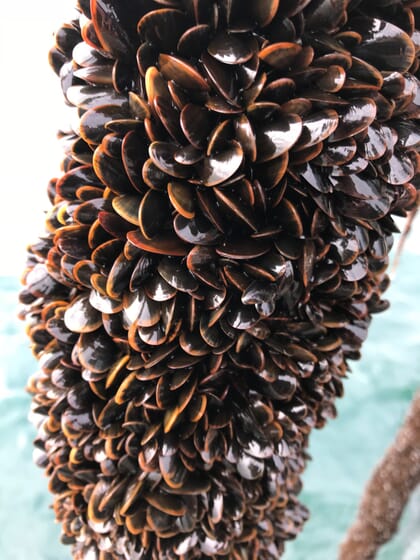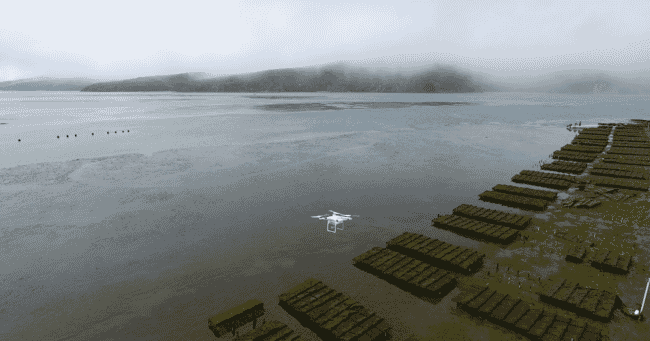A meta-analysis published in Aquaculture Reports reveals that mussel and oyster farming is likely to remove nearly 334 tonnes of nitrogen per year from Atlantic Canada’s nearshore ecosystems – representing a major step in bioremediation efforts. The study also found that suspended mussel aquaculture removed more environmental nitrogen per hectare of farm area than suspended or ground-based oyster aquaculture.

Based on these factors, the researchers concluded that growing and harvesting shellfish, especially mussels, has a restorative effect on nearshore ecosystems.
Background
In Atlantic provinces like New Brunswick (NB) and Prince Edward Island (PEI), nutrient run-off from agriculture has damaged coastal and estuarine ecosystems. The increased nitrogen concentration in the water contributes to eutrophication – the enrichment of water by nutrient salts. This process negatively impacts water quality and contributes to toxic algal blooms and dead zones in the water.
Shellfish aquaculture has been trialled as a method to mitigate eutrophication. Since bivalves are filter-feeders, they can potentially extract excess nutrients form the water. They’re also able to incorporate phytoplankton and carbon into their tissues as they mature before harvest. For nitrogen specifically, bivalves can remove it from the surrounding water by absorbing it in their shells and burying it in sediments.
Other case studies have suggested that oyster and mussel aquaculture have the same denitrification potential as wild oyster and mussel beds. These studies also indicate that bivalve aquaculture provides major ecosystem benefits. Oysters and mussels enhance the bottom habitat of coastal areas and can stimulate sediment creation, nutrient cycling and carbon sequestration.

© Torrey Johnson
The study
The researchers wanted to quantify the amount of nitrogen removed from shellfish farms in eastern Canada. They also wanted to compare the nitrogen removal potential of mussels and oysters by examining the percentage of nitrogen in the species’ shells and tissues.
In order to do this, the authors reviewed data from the agriculture and aquaculture boards of New Brunswick (NB) and Prince Edward Island (PEI). This tracked shellfish farms and the species they were producing. Two shellfish species are farmed in the region: mussels (Mytilus edulis) and oysters (Crassostrea virginica). Based on the collected data, the researchers created a statistical model that explored four key areas.
Firstly, the researchers determined the nitrogen removal potential (NRP) for each species when it was farmed. Secondly, they quantified the NRP of each province’s aquaculture efforts. Thirdly, the model explored which farming methods provided the greatest NRP. As a final step, the researchers wanted to determine if there was a correlation between the number of bivalve aquaculture leases and total NRP for each province.
Findings
The study found that mussels absorbed more nitrogen from the surrounding environment than oysters. When comparing the two species, the researchers noted that mussels were able to incorporate more nitrogen into their shells – meaning that more nitrogen would be removed from the bay at harvest.
Initial analysis indicates that shellfish harvests in NB and PEI typically remove more than 10 percent of the total nitrogen load on bays. The NRP increases on sites that practice intensive farming, and in water that already has a low nitrogen content.
Based on the data, suspended mussel farming had the greatest NRP per hectare of any of the farming methods used. Suspended and bottom oyster aquaculture did not perform as well.
The researchers also found a positive relationship between the number of shellfish farming leases and the total NRP of each province. This means that as the number of leases increased, the provincial NRP increased as well.
However, the authors did not want to conclude that mussels are always superior bioremediation tools. They emphasise that the species farmed, biomass at harvest, number of individuals harvested and frequency of harvesting all had a bearing on the NRP. Changes in any of these variables would influence NRP totals.
The results suggest that mussel and oyster farming can remove a substantial amount of nitrogen from coastal regions. Based on this analysis, the researchers conclude that aquaculture is a successful and more economically viable bioremediation strategy than other mitigation efforts.
Key take-aways
The authors of the study emphasise that shellfish aquaculture doesn’t completely prevent eutrophication. Bivalve culture should be used in conjunction with other methods in order to maximise bioremediation efforts.
Additionally, despite the strong NRP statistical model used in this study, there are some limitations. The study didn’t track nitrogenous sediments in the sand or overall nitrogen retention in coastal ecosystems. Researchers still need to conduct a full nitrogen budget to get a more accurate model of the ecosystem.
Based on the results from the analysis, the authors conclude that mussel and oyster farming have the potential to sustainably remove substantial amounts of nitrogen and excess nutrients from nearshore environments.




